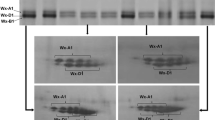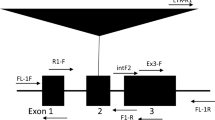Abstract
The naturally occurring waxy and low-amylose variants of foxtail millet and other cereals, like rice and barley, originated in East and Southeast Asia under human selection for sticky foods. Mutations in the GBSS1 gene for granule-bound starch synthase 1 are known to be associated with these traits. We have analyzed the gene in foxtail millet, and found that, in this species, these traits were originated by multiple independent insertions of transposable elements and by subsequent secondary insertions into these elements or deletion of parts of the elements. The structural analysis of transposable elements inserted in the GBSS1 gene revealed that the non-waxy was converted to the low-amylose phenotype once, while shifts from non-waxy to waxy occurred three times, from low amylose to waxy once and from waxy to low amylose once. The present results, and the geographical distribution of different waxy molecular types, strongly suggest that these types originated independently and were dispersed into their current distribution areas. The patterns of GBSS1 variation revealed here suggest that foxtail millet may serve as a key to solving the mystery of the origin of waxy-type cereals in Asia. The GBSS1 gene in foxtail millet provides a new example of the evolution of a gene involved in the processes of domestication and its post-domestication fate under the influence of human selection.





Similar content being viewed by others
References
Afzal M, Kawase M, Nakayama H, Okuno K(1996) Variation in electrophoregrams of total seed protein and Wx protein in foxtail millet. In: Janick J (ed) Progress in new crops. ASHS Press, Alexandria, Va., pp 191–195
Collins GN (1909) A new type of Indian corn from China. USDA Bur Pl Ind Bull 16:1–30
Devos KM, Gale MD (2000) Genome relationships: the grass model in current research. Plant Cell 12:637–646
Doebley J, Stec A, Gustus C (1995) Teosinte branched1 and the origin of maize: evidence for epistasis and the evolution of dominance. Genetics 141:333–346
Doebley J, Stec A, Hubbard L (1997) The evolution of apical dominance in maize. Nature 386:485–488
Domon E, Fujita M, Ishikawa N (2002) The insertion/deletion polymorphisms in the Waxy gene of barley genetic resources from East Asia. Theor Appl Genet 104:132–138
Doust AN, Kellogg EA (2002) Inflorscence diversification in the panicoid “bristle grass” clade (Paniceae, Poaceae): evidence from molecular phylogenies and developmental morphology. Amer J Bot 89:1203–1222
Doust AN, Devos KM, Gadberry MD, Gale MD, Kellogg EA (2004) Genetic control of branching in foxtail millet. Proc Natl Acad Sci 101:9045–9050
Doust AN, Devos KM, Gadberry MD, Gale MD, Kellogg EA (2005) The genetic basis for inflorescence variation between foxtail and green millet (Poaceae). Genetics 169:1659–1672
Fogg WH (1983) Swidden cultivation of foxtail millet by Taiwan aborigines: a cultural analogue of the domestication of Setaria italica in China. In: Keighty DN (ed). The Origins of Chinese Civilization. Univ California Press, Berkeley, pp 95–115
Frary A, Nesbitt TC, Grandillo S, Knaap E, Cong B, Liu J, Meller J, Elber R, Alpert KB, Tanksley SD (2000) fw2.2: a quantitative trait locus key to the evolution of tomato fruit size. Science 289:85–88
Fukunaga K, Kawase M, Kato K (2002) Structural variation in the waxy gene and differentiation in foxtail millet [Setaria italica (L.) P. Beauv.]: implications of multiple origins of the waxy phenotype. Mol Genet Genomics 268:214–222
Harlan JR (1992) Crops and man. Amer Soc Agron, Madison
Hirano HY, Sano Y (1991) Molecular characterization of the waxy loci of rice (Oryza sativa). Plant Cell Physiol 32:989–997
Hirano HY, Eighuchi M, Sano Y (1998) A single base change altered the regulation of the Waxy gene at the posttranscriptional level during the domestication of rice. Mol Biol Evol 15:978–987
Inukai T, Sako A, Hirano HY, Sano Y (2000) Analysis of intragenic recombination at wx in rice: correlation between the molecular and genetic maps within the locus. Genome 43:589–596
Isshiki M, Morino K, Nakajima M, Okagaki RJ, Wessler SR, Izawa T, Shimamoto K (1998) A naturally occurring functional allele of the rice waxy locus has a GT to TT mutation at the 5′ splice site of the first intron. Plant J 15:133–138
Jiang N, Wessler SR (2001) Insertion preference of maize and rice MITEs as revealed by the analysis of nested elements. The Plant Cell 13:2553–2564
Jurka J, Klonowski P, Dagman V, Pelton P (1996) CENSOR—a program for identification and elimination of repetitive elements from DNA sequences. Comp Chem 20:119–122
Li Y, Wu SZ (1996) Traditional maintenance and multiplication of foxtail millet (Setaria italica (L.) P. Beauv) landraces in China. Euphytica 87:33–38
Murray MG, Thompson WF (1980) Rapid isolation of high molecular weight plant DNA. Nucleic Acids Res 8:4321–4325
Nakayama H, Afzal M, Okuno K (1998) Intraspecific differentiation and geographical distribution of Wx alleles for low amylose content in endosperm of foxtail millet, Setaria italica (L.) Beauv. Euphytica 102:289–293
Nelson OE (1957) The feasibility of investing “genetic fine structure” in higher plants. Am Nat 91:331–332
Okuno K, Fuwa H, Yano M (1983) A new mutant gene lowering amylose content in endosperm starch in rice, Oryza sativa L. Japan J Breed 33:387–394
Olsen KM, Purugganan MD (2002) Molecular evidence on the origin and evolution of glutinous rice. Genetics 162:941–950
Peng J, Richards DE, Hartley NM, Murphy GP, Devos KM, Flintham JE, Beales J, Fish LJ, Worland AJ, Pelica F, Sudhakar D, Christou P, Snape JW, Gale MD, Harberd NP (1999) ‘Green revolution’ genes encode mutant gibberellin response modulators. Nature 400:256–261
Ren S (1996) Several major achievements in early Neolithic China, ca. 5000 BC. (in Chinese). Kaogu (Archaeology) 37–49
Sakamoto S (1987) Origin and dispersal of common millet and foxtail millet. Japan Agr Res Quart 21:84–89
Sakamoto S (1996) Glutinous-endosperm starch food culture specific to Eastern and Southeastern Asia. In: Ellen R, Fukui K (eds) Redefining Nature: ecology, culture and domestication. Berg Publishers, Oxford, pp 215–231
San Miguel P, Gaut BS, Tikhonov A, Nakajima Y, Bennetzen JL (1998) The paleontology of intergene retrotransposons of maize. Nat Genet 20:43–45
Sano Y (1984) Differential regulation of waxy gene expression in rice endosperm. Theor Appl Genet 68:467–473
Takei E (1994) Characteristics and ethnobotany of millets in the Southwestern (Nansei) Islands of Japan (in Japanese with English abstract). Ph.D thesis, Faculty of Agriculture, Kyoto University
Tatusova TA, Madden TL (1999) Blast 2 sequences—a new tool for comparing protein and nucleotide sequences. FEMS Microbiol Lett 174:247–250
Umeda M, Ohtsubo H, Ohtsubo E (1991) Diversification of the rice Waxy gene by insertion of mobile DNA elements into introns. Jpn J Genet 66:569–586
Varagona MJ, Purugganan M, Wessler SR (1992) Alternative splicing induced by insertion of retroposons into the maize Waxy gene. Plant Cell 4:811–820
Wang RL, Stec A, Hey J, Lukens L, Doebley J (1999) The limits of selection during maize domestication. Nature 398:236–239
Wessler SR, Varagona MJ (1985) Molecular basis of mutations at Waxy locus of maize: correlation with the fine structure genetic map. Proc Natl Acad Sci USA 82:4177–4181
Whitt SR, Wilson LM, Tenaillon MI, Gaut BS, Buckler ES (2002) Genetic diversity and selection in the maize starch pathway. Proc Natl Acad Sci USA 99:12959–19562
Yamanaka S, Nakamura I, Watanabe KN, Sato Y (2004) Identification of SNPs in the waxy gene among glutinous rice cultivars and their evolutionary significance during the domestication process of rice. Theor Appl Genet 108:1200–1204
Yano M, Katayose Y, Ashikari M, Yamanouchi U, Monna L, Fuse T, Baba T, Yamamoto K, Umehara Y, Nagamura Y, Sasaki T (2000) Hd1, a major photoperiod sensitivity quantitative trait locus in rice, is closely related to the Arabidopsis flowering time gene CONSTANS. Plant Cell 12:2473–2484
Yoshida S (2002) Wild food plants and vegeculture. In: Yoshida S, Matthews PJ (eds) Vegeculture in Eastern Asia and Oceania. JCAS Symposium Series No. 16, National Museum of Ethnology, Osaka, pp 31–44
Acknowledgements
We thank all those who have kindly provided plant materials for the study. M.K was a senior researcher at the National Agricultural Research Center for Western Region, where a portion of this work was conducted.
Author information
Authors and Affiliations
Corresponding author
Additional information
Communicated by M.-A. Grandbastien
Electronic supplementary material
Rights and permissions
About this article
Cite this article
Kawase, M., Fukunaga, K. & Kato, K. Diverse origins of waxy foxtail millet crops in East and Southeast Asia mediated by multiple transposable element insertions. Mol Genet Genomics 274, 131–140 (2005). https://doi.org/10.1007/s00438-005-0013-8
Received:
Accepted:
Published:
Issue Date:
DOI: https://doi.org/10.1007/s00438-005-0013-8




